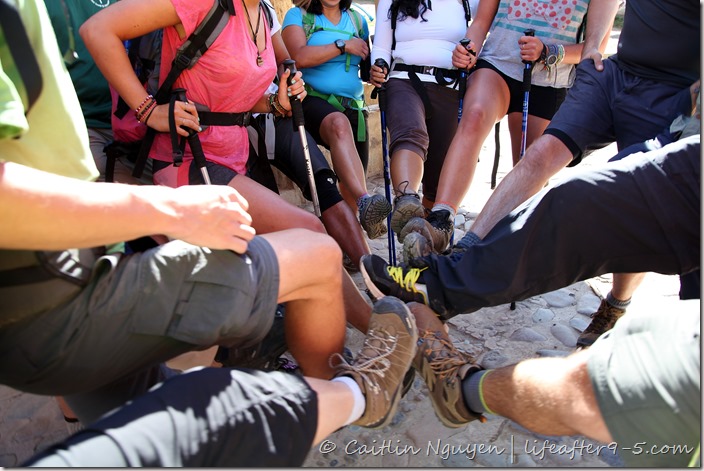
Getting ready for the Inca trek
Finally, after all the preparation and anticipation, we made it to the day of the trek. Starting off from Ollantaytambo, we packed our bags, said goodbye to civilization and got on the bus taking us to the km marker 82, the official start of our Inca trail. As we wound our way along the Urubamba river, the bus driver was blasting music, pumping us up for the adventure ahead. Sitting at the back of the bus, staring out at the Andes mountains I contemplated if I really wanted to go through with it and if there was time to turn back when I heard the lyric “everything that kills me makes me feel alive”. I think that’s a sign.

Hiking on the first day
Starting out we didn’t really know what to expect, even though we got some practice in the Sacred Valley. About 20 minutes in, we made a stop on the side of the trail to make our coca leaf offering to Pachamama, wishing and praying for a successful trip. Here are the highlights of our trek:

Beautiful scenery along the way
Day One: 6 hours, 11 km/6.8 miles
The first day, the road was fairly flat and wide, making the hike manageable. There were many easy ups and downs, except for a steep incline that came out of nowhere and took us by surprise. After that initial steep climb, we rested under an avocado tree, eating a banana we were provided as a snack. I have to tell you, banana never tasted so good, and I don’t even like bananas.

Resting under an avocado tree
The porters, who started at the same time as us, somehow got to camp ahead of us, set up tents, and began cooking lunch. We came rolling in and were greeted with a bowl of water that we used to wash our hands before proceeding to a 3 course meal prepared for us by our chef. The food was delicious especially after all the hiking. After lunch, we resumed walking to our rest stop, while the porters packed up camp.
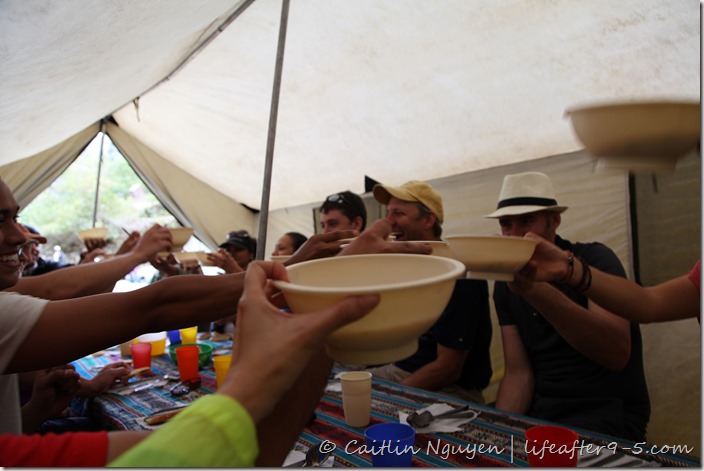
Lunch have never tasted so good before
That night at camp before dinner, we had happy hour where we drank tea and cocoa and played games. We taught our guides how to play Mad Libs and a very heated game of spoons (Fausto won!) and they in turn taught us how to play Paca/Puma. One person in the group begins by pointing to another person and saying “Paca”, this will repeat until someone is called “Puma.” At that point, the two people on either side of the “Puma” have to raise their arms and scream “Machu Picchu”. The last person to do this will become the next “Paca.” Our group was easily the loudest all around the camp.
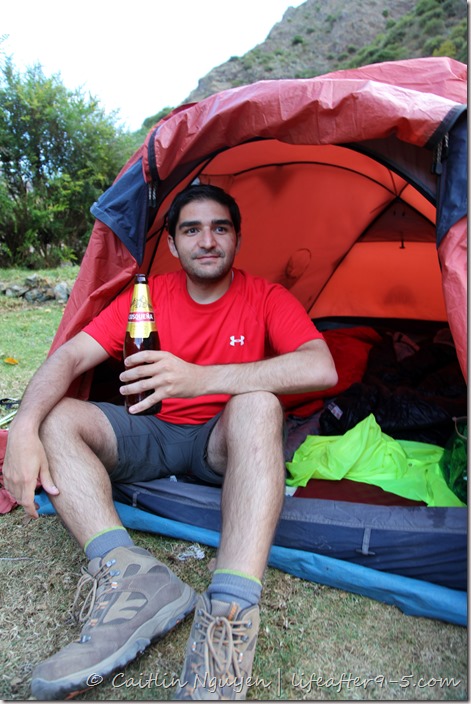
Fausto’s reward at the first camp site.
Day Two: 7 hours, 12 km/7.5 miles
This was the toughest day of the trek, where we had to climb to the summit of Dead Woman’s Pass at 4,200 meters/14,000 feet above sea level. It was grueling and I could not take more than 10 steps at a time without stopping to rest. We were encouraged to climb at our own pace, so we were all dispersed throughout the hike. For me, distance and time was measured by the big rocks along the way where I sat down to rest. I counted down the steps to the next big rock as I lifted my weary feet. Each time I sat down, I looked over my shoulder and took in the breathtaking beauty of the surrounding mountains and it gave me a little bit more energy to continue.
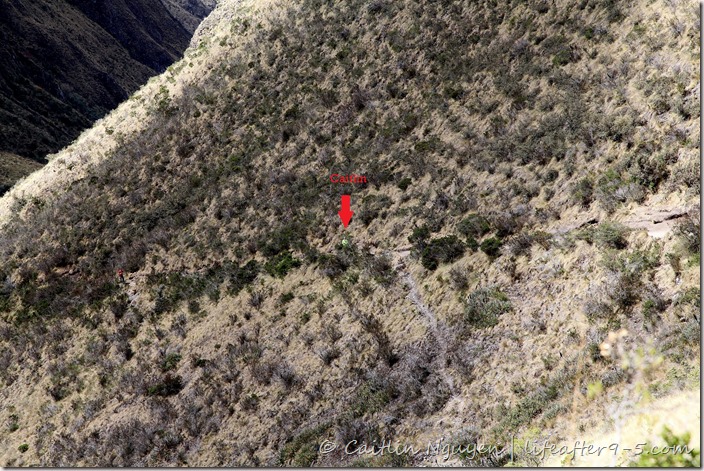
Steep climb on the second day

Resting every few steps to catch my breath

View from Dead Woman’s Pass, we were at the bottom in the morning
Our group decided to start early and forgo lunch until we made it to camp. It was a great idea because I would not have been able to climb up the mountain with a belly full of food. Along the road, countless porters zipped right past us with their 26 kg/55lb bag on their back, making it look like they were going for a stroll in the park. Slow and steady, we climbed up and finally made it to the top of Dead Woman’s pass. The view from this vantage point was gorgeous, you could see the snow-capped mountain and the valley below. Nearby were many rock piles that had accumulated from other hikers over the years. Travelers from all over the world would pick a special rock and bring it all the way to the top to add to the pile as their way of thanking Pachamama for making it thus far.
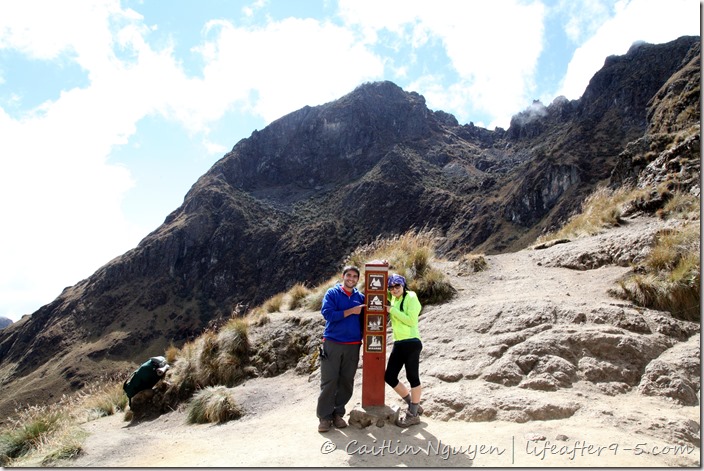
We made it to the top of Dead Woman’s Pass at 14,000 feet

Staring into the distance

Rocks at the top of Dead Woman’s pass from previous travelers
After resting at the top of Dead Woman’s pass, we headed downhill to our camp on the other side of the mountain. The way up was hard on my lungs and the way down was hard on my ankles. My feet actually slipped a few times but the well-fitted hiking boots and the walking sticks kept me from any injuries. We finally made it to camp at 2:30 in the afternoon, elated with our success in overcoming the hardest day. We camped by a waterfall, so Fausto and I decided to go down and sit by the water to soak our feet. The water was icy cold, and it was hard to keep our feet in longer than 30 seconds at a time. We grabbed our bandanna and used it as a wash cloth to scrub off the filth from the last 2 days. It felt amazing to be clean again even if it was only for an evening.
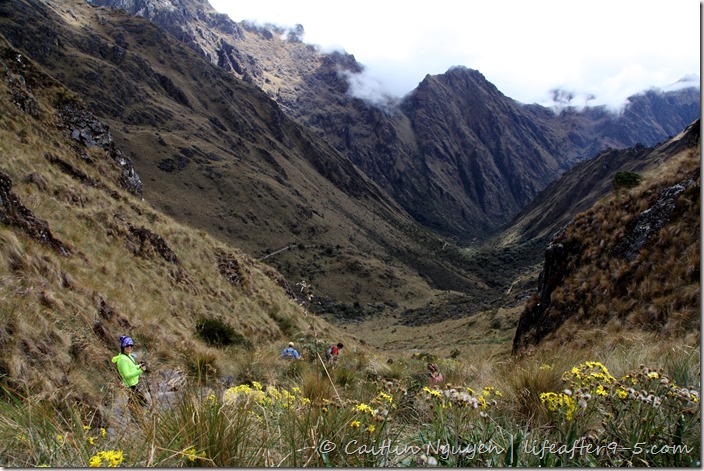
Going down the other side of the mountain
That night, the sky lit up with a million stars twinkling in the distance. You could even see the Milky Way spread across the Southern sky. As a city girl, there are not many opportunities to go stargazing and the beauty of the celestial sky took my breath away. Determined to capture this moment, I sat outside for over an hour in the freezing cold, playing with the various settings of my camera trying to take the perfect photo.

Milky Way lit up the cloudless sky
Day Three: 8 hours, 16 km/10 miles
On the third day, the hike was long but not as grueling as the prior two. There were more parts where the path was narrow and treacherous and I had to be careful to hug the mountain so that I didn’t fall down. We visited a few archaeological sites along the way and learned about more Inca history from our guides. We learned that the Inca territory at it largest encompassed all the way north from Colombia, to Chile in the south, and Ecuador in the west, with Cusco at the heart of the empire. The expansive Inca roads were built to connect all the different cities. One of the places we visited was an outpost where the runners would meet up to relay their messages. It took the runners about 5 hours to get from Cusco to Machu Picchu, using the relay method where each runner would go for 15-20 km.

Pit stop at an archaeological site

Looking over the Urubamba river below, we are almost at Machu Picchu
Day Four: 2 hours, 4 km/2.5 miles
On the last day, we had to wake up at 3:30 am to line up at the check point, waiting for it to open at 5:30 am. Standing still in the dark was the coldest I’d felt throughout the entire trip. It was a struggle to stay warm and feel motivated for the last leg of the trek. We passed the time by gazing at the stars. The sky was so clear, we were able to see international space station zipping across the sky, and then I saw my first ever shooting star. Time to make a wish!

Huddle together in the dark, waiting for the checkpoint to open
The gate finally opened at 5:30 am and we rushed to get to the Sun gate hoping to see the sun rise. Imagine a narrow road on the side of the mountain, in the dark, with slippery rocks. Now imagine jogging on it for several hours. Right before the gate, we were faced with a wall of steps that seemed to go on forever. This was the last hurdle we had to overcome before finally getting our first glimpse of Machu Picchu. We were lucky because the sky was clear and we were able see the ancient city below. The view did not disappoint.

Looking at Machu Picchu from the Sun Gate
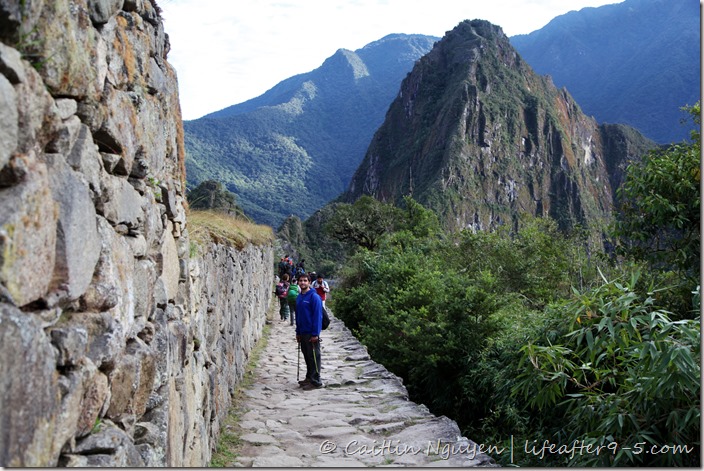
Hiking down into the Sacred city
Machu Picchu was full of energy, not just from the intense sun but from the thousands of people who were visiting hoping to connect with the bygone world and yearning to learn about its mysterious past. Up close, the place was even more massive than I imagined. The location of the sacred city was chosen especially for its religious significance to the Inca culture. The Sun temple located in the middle of Machu Picchu is the most important structure in the city. During the solstices, the sun shines through the temple window and aligns the ritual stone with the tip of a nearby mountain peak.
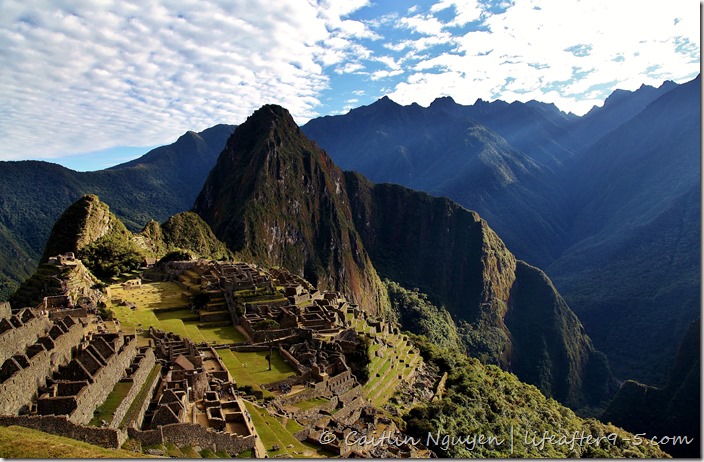
Machu Picchu on a clear sunny day

Sun Temple with the Royal tomb underneath
The architecture of the city was built to harmonize with the natural formation of the mountain. The hundreds of buildings staggered throughout the city are made up of colossal stone blocks harvested from the nearby quarry. Each block was fitted together so tightly that there was no need for mortar. This technique helped make the structure more resilient towards earthquakes and natural disasters and preserved it until this day.
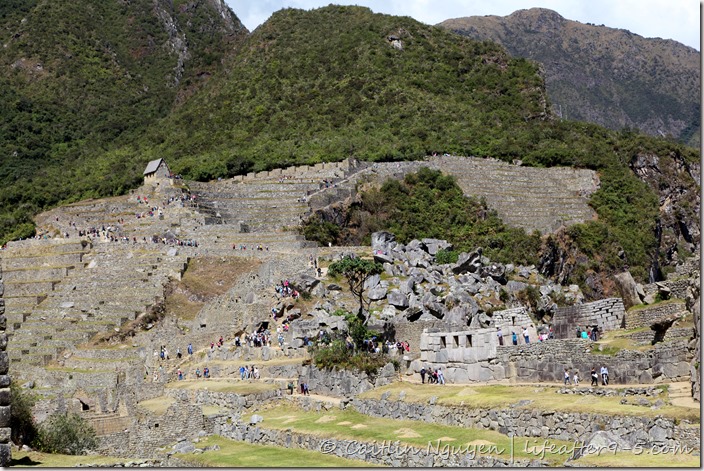
The terraced steps built into the side of the moutain
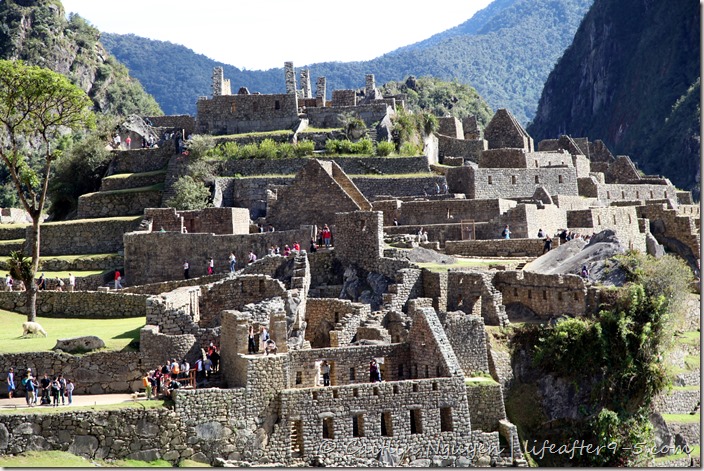
The many buildings of Machu Picchu
After four days, the fatigue had started to set in, so we decided to find a nice spot in the shade to sit back and enjoy the view. Sitting on the steps of Machu Picchu, I had a chance to reflect on the whole journey. The same journey taken by people hundreds of years ago. It made me feel connected to the people that were once here.

Sitting back and enjoying the view
We were very lucky that there was no rain on all four days of our hike. The trek was hard enough without the added challenge of a wet slippery road. Each day presented a different challenge. On the first day, we were not prepared, so the initial ascent was painful. Followed by a second day where we hiked uphill for 5 straight hours. The third day was supposed to be easy, but the narrow road and the longer distance made it a pretty tough day as well. On the last day, we thought we could breathe a sigh of relief only to find out that we had to hike in the dark through the jungle, trying not to fall down the side of the mountain.
Now sitting at home, having the hindsight of my experience I can truly say that it was worth all the discomfort and hard work. Machu Picchu was magnificent and even more beautiful after our pilgrimage through the mountains. We got to traverse the route that many Incas took to pay homage to their Sun God. That feeling that you are now part of the history of a proud ancient race is indescribable.


I love traveling because it expand your mind and allows you to see that you are not the center of the world. It also makes you appreciate the little things that you sometime take for granted at home. It is especially evident on this trip where we had to go without flush toilets, a comfortable bed, and clean socks/underwear (especially towards the end!). These are things that we have at home and perhaps don’t appreciate as much as we should. It was the best feeling when we finally showered and changed into clean clothes after we got back to civilization.
This concludes our first trip down to South America. We met some incredible people, immersed ourselves in the culture and learned about the ancient Inca Empire. Check back soon for our trip report and travel tips on what you need to bring on the Inca trek. For more pictures of our trip, check out our Facebook page.

Our guide, Evert brought us all the way to Machu Picchu and shared with us all his knowledge of the ancient Inca
Information Round-up:
Inca Trek Tour: G Adventure, 5 days of tour + 2 days hotel in Cusco, $1149 [On sale right now for $977 for 9/15 tour date]
Total Hike: 44 km/26.8 miles



Hard work ! I don t think i can make it. Any way u and Fausto did very well, and u look not tire at all. Congratulation!
LikeLike
Pingback: Travel Tips: What to Pack for the Inca Trek | life after 9to5
Pingback: Trip Report: Peru | life after 9to5
Pingback: Winter Storm | life after 9to5
Pingback: The Day My Life Changed | life after 9to5
Pingback: New Zealand: Roy’s Peak | life after 9to5